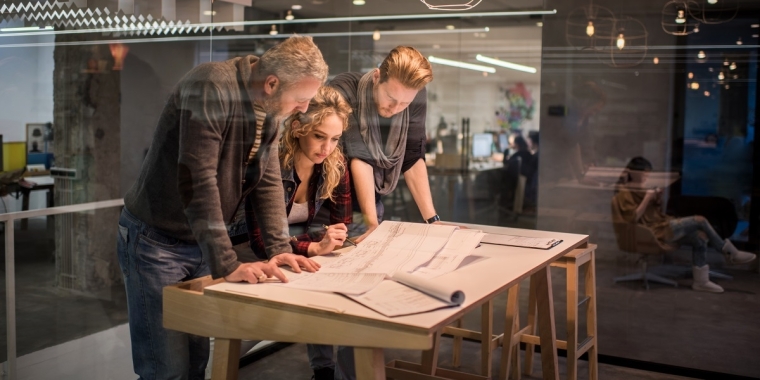Mon 20th Jun 2022
Should I register a product design? Or can I rely on copyright?
Services: Design rights, IP portfolio management, Learning and development, Start up or scale up
Sectors:
For any business which is launching a new product, tough decisions need to be made about where to invest your (often scarce) financial resources. Should you attend this trade fair? Or visit more suppliers? Invest in more marketing or build up the sales team?

One item of expenditure which is often delayed is that of intellectual property protection, particularly when it comes to product design. But as many entrepreneurs and businesses have discovered, this can be a false economy in the long run, particularly when you spot a copycat item and then face a costly battle to stop a competitor from using your design.
David Roberts, partner and expert in the protection of design rights, answers some of the questions commonly posed by manufacturers who are new launching products or expanding overseas:
Q: I thought that all designs are protected by copyright, which is free isn’t it?
The appearance of products and designs can benefit from some intellectual property protection under a type of copyright, often known as an ‘unregistered design right’, which does enable the rights owner (you) to stop a third party copying your design.
As there is no registration involved, there is no cost for obtaining the right.
However, the protection provided by an ‘unregistered design right’ is often patchy and does not apply to all designs or in all countries. Also, the protection often only lasts for a short period of time.
Q: What is the difference between copyright and a design right?
Design rights specifically cover industrial designs. The term copyright is rather broader and protects copyright in books, music, photography, art, etc.
In many countries, while a one-off sculpture or a painting would be covered by copyright, the design of a lampshade or a smart phone or a design for wallpaper or fabric would be covered by design rights.
Q: When does the unregistered protection start?
In the UK and Europe, protection via an unregistered design right typically comes into existence as soon as the design is created or first published.
However, it is important to note that a number of countries provide no unregistered protection for industrial designs – so you will need to look at international markets on a country-by-country basis.
Q: Does unregistered protection extend to export markets?
In a number of countries there are territorial requirements. This means that only nationals or residents of certain countries qualify for protection of unregistered designs, or protection is only available if the design was first published in a particular country.
Again, you will need to plan on a country-by-country basis.
Q: If I decide not to register my designs, how long does protection last?
In the countries that do provide protection for unregistered industrial designs, the protection may only last for a short time, and there are all sorts of nuanced rules which apply.
If you have already started to market your products and designs, for example at a trade show, on the internet, etc., then this can have an impact on any period of protection.
At this point, if you are concerned about protecting your products and designs, it would be advisable to consult one of our design attorneys who, for a small charge, can check the rules in the countries of interest and advise you on the risks.
Q: How easy is it to stop someone copying a design that I have not registered?
To be successful in stopping a third party making the same or similar design, you will need to prove that you have unregistered design rights in your design. This typically requires meeting tests for originality, for example by providing the original design documents, and there may be other requirements. This in itself can be a difficult and time-consuming exercise. You also need to show that they copied your design, as independent design activities would not be an infringement of unregistered rights.
Q: It sounds like this approach gives me some protection, but it would not be very long lasting and may not be effective in all our overseas markets.
That is correct.
In short, unregistered design rights exist automatically if the relevant requirements are met and there are no fees associated with obtaining an unregistered design right.
However, the existence of and protection provided by an unregistered design right is patchy and is not guaranteed in all countries for all nationals or residents or for all designs, and an unregistered design right can be difficult to enforce.
Q: How long does protection last if I register my design?
The term of protection is typically longer, for example:
- Up to a maximum of 25 years in the UK and the EU;
- 14 years in the US.
Q: How easy is it to stop someone copying a design that I have registered?
The existence of a registered design is easy to prove to a third party by simply providing a copy of the registered design.
Ownership of the registered design is prima facie evidence of ownership of the associated rights. Also, it is not necessary to show that the third party copied the design as independent production of the same or similar design will infringe a registered design.
Q: Does registering a design have any other benefits?
It is a common experience that the mere existence of a registered design is often a practical deterrent to third parties producing a similar design.
Q: How should we budget for registering a design?
The fees associated with obtaining a registered design typically include:
- official Patent Office filing costs;
- grant fees;
- renewal fees; and
- professional services of advisors for filing and obtaining the registered design.
One of the ways that we help our clients is by looking at all the countries where they operate, and we use our experience to recommend the most cost-effective means of obtaining the maximum protection.
Q: So, when would it be a good idea to pay to register a design?
With a registered design, you can obtain more extensive protection in terms of geography and timeframe and so the costs may be justified for high value products and for designs that are expected to be sold for longer periods of time, at least in your biggest markets.
Registering your design will avoid most of the pitfalls and limitations of relying on an unregistered design right or other rights such as copyright.
Q: And how can you help?
To be successfully registered, most countries require that the design is new and sufficiently different from existing designs. We can advise you on whether your design is likely to meet this test. Note that some countries require that the design has been kept secret until the registered design application is filed, so it is best to contact us well in advance of publishing any details of the design.
A registered design confers a territorial right, limited to one or more countries. Once we understand the international extent of your actual and target markets, we can advise on the best approach to securing protection for the design and arrange for the design to be registered, whether this is via one or more of:
- a UK national registered design, which covers the UK only;
- a German national registered design, which covers Germany only;
- a Registered Community Design (RCD), which provides protection throughout the whole of the European Union; or
- elsewhere in the world via local national registered designs in other countries and/or international designs.
For more information on registering a design, or any aspect of intellectual property protection visit www.pagewhite.com or contact David Roberts.
This briefing is for general information purposes only and should not be used as a substitute for legal advice relating to your particular circumstances. We can discuss specific issues and facts on an individual basis. Please note that the law may have changed since the day this was first published in June 2022.


